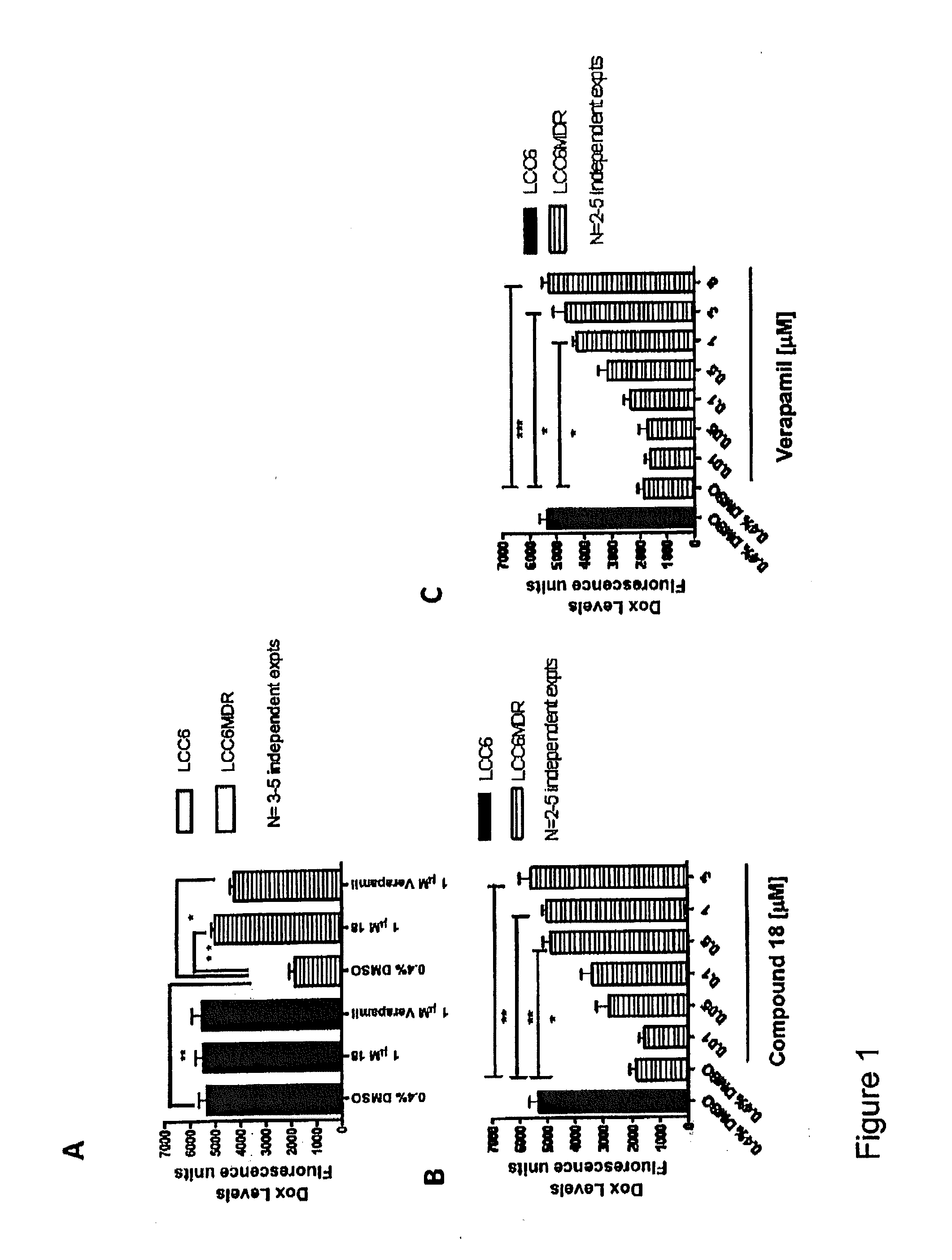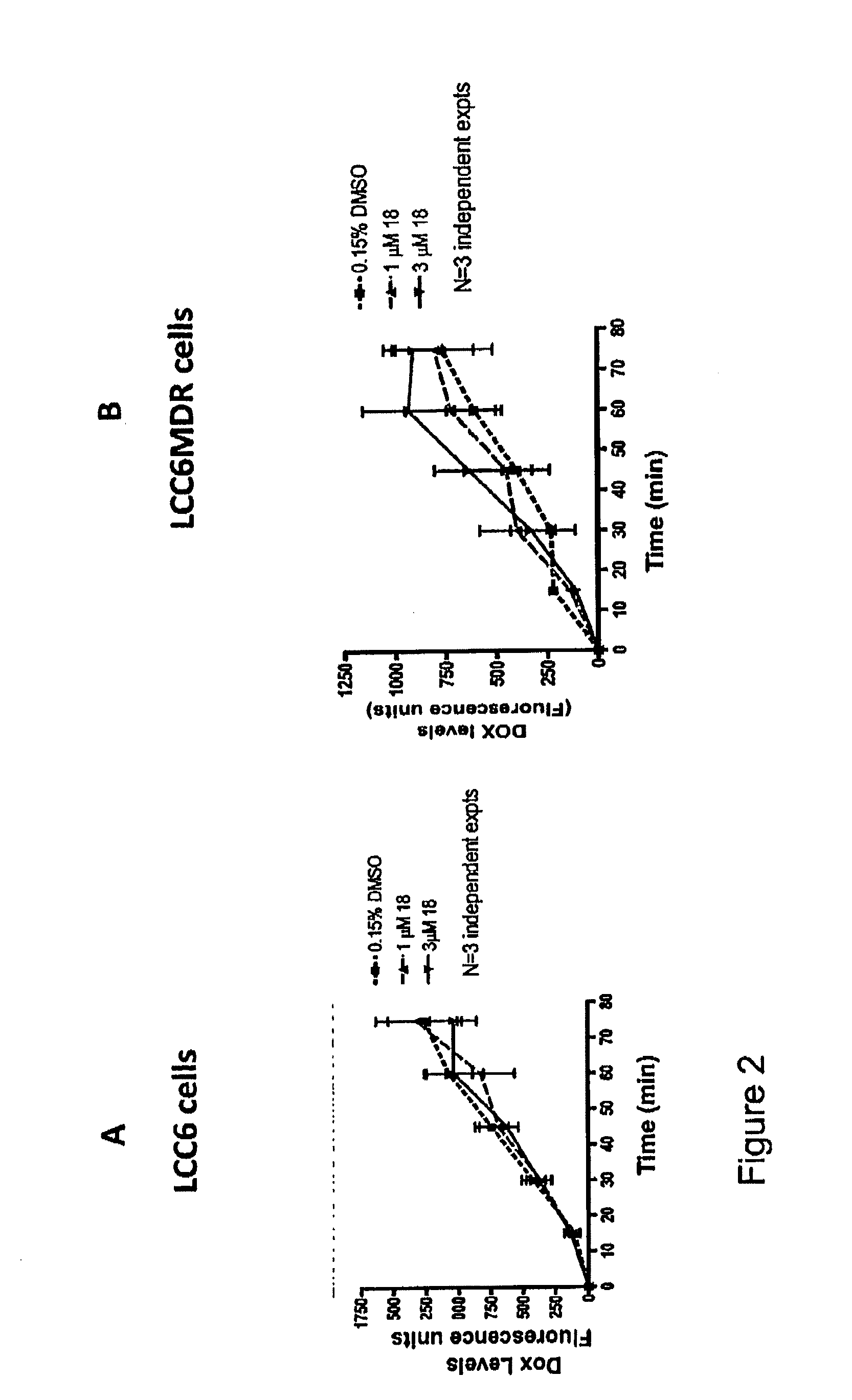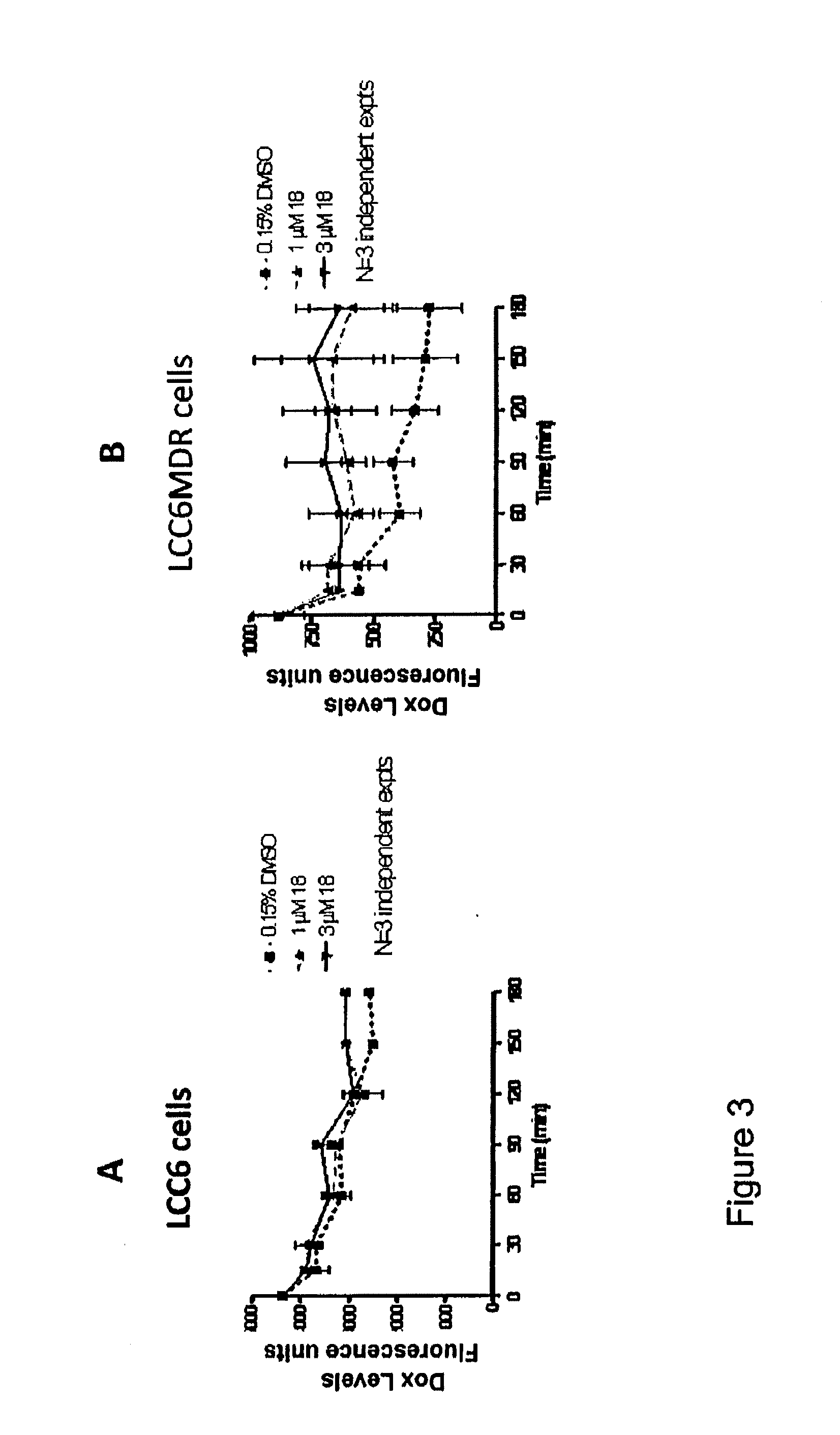Flavonoid dimers and their use
a technology of flavonoid dimers and flavonoid compounds, applied in the field of flavonoid compounds, can solve the problems of limited clinical utility, side effects, and limiting the clinical outcome of chemotherapy of multidrug resistance, and achieve the effect of reducing p-glycoprotein based multidrug resistan
- Summary
- Abstract
- Description
- Claims
- Application Information
AI Technical Summary
Benefits of technology
Problems solved by technology
Method used
Image
Examples
example 1
1,13-Bis[4′-(4H-chromen-4-on-2-yl)phenyl]-N-(tert-butyloxycarbonyl)-1,4,10,13-tetraoxa-7-azamidecane (16a)
[0159]The titled compound 16a was obtained from flavone 27a (4.8 g, 20 mmol), ditosylate 28 (6.1 g, 10 mmol), K2CO3 (3.5 g) and DMF (30 mL) as a white foam (5.2 g, 70%) according to the general procedure described above: 1H NMR (CDCl3) δ 1.42 (s, 9H), 3.45 (s, 4H), 3.62 (s, 4H), 3.69 (s, 4H), 4.08 (s, 4H), 6.60 (s, 2H), 6.94 (d, J=8.4 Hz, 4H), 7.30 (d, J=6.4 Hz, 2H), 7.43 (d, J=8.0 Hz, 2H), 7.57 (d, J=6.4 Hz, 2H), 7.75 (d, J=8.4 Hz, 4H), 8.12 (d, J=7.2 Hz, 2H); 13C NMR (CDCl3) δ 28.4, 47.6, 47.9, 67.5, 69.1, 69.2, 69.9, 70.1, 79.6, 106.0, 114.9, 117.9, 123.8, 123.9, 125.0, 125.4, 127.8, 133.5, 155.4, 156.0, 161.5, 163.1, 178.1; LRMS (ESI) m / z 734 (M++H, 77), 756 (M++Na, 100); HRMS (ESI) Calcd for C43H44NO10(M++H) 734.2965, found 734.2979.
example 2
1,13-Bis[4′-((4H-chromen-4-on-2-yl)-3′-methoxyphenyl)]-7-(tert-butylformyl)-1,4,10,13-tetraoxa-7-azamidecane (16b)
[0160]The titled compound 16b was obtained from 4′-hydroxyflavone 27b (0.18 g, 0.67 mmol), ditosylate 28 (0.20 g, 0.33 mmol), K2CO3 (0.12 g) and DMF (6 mL) as a white foam (0.14 g, 53%) according to the general procedure I described above: 1H NMR (CDCl3) δ 1.40 (s, 9H), 3.45 (s, 4H), 3.61 (s, 4H), 3.79 (s, 4H), 3.87 (s, 6H), 4.13 (s, 4H), 6.63 (s, 2H), 6.89 (d, J=6.4 Hz, 2H), 7.30 (d, J=6.4 Hz, 2H), 7.43 (d, J=8.0 Hz, 2H), 7.57 (d, J=6.4 Hz, 2H), 7.75 (d, J=8.4 Hz, 4H), 8.12 (d, J=7.2 Hz, 2H); 13C NMR (CDCl3) δ 28.4, 47.6, 47.9, 56.0, 68.4, 69.0, 69.2, 69.9, 70.2, 79.5, 106.3, 109.1, 112.8, 117.9, 119.7, 123.7, 124.3, 125.0, 125.4, 133.5, 149.5, 151.4, 155.4, 156.0, 163.1, 178.1; LRMS (ESI) m / z 794 (M++H, 27), 816 (M++Na, 100); HRMS (ESI) Calcd for C45H48NO12(M++H) 794.3177, found 794.3170.
example 3
1,13-Bis[4′-((5-methoxy)-4H-chromen-4-on-2-yl)phenyl]-7-(tert-butyloxycarbonyl)-1,4,10,13-tetraoxa-7-azamidecane (16d)
[0161]The titled compound 16d was obtained from 4′-hydroxyflavone 27d (80 mg, 0.30 mmol), ditosylate 28 (90 mg, 0.15 mmol), K2CO3 (60 mg) and DMF (5 mL) as a white foam (69 mg, 58%) according to the general procedure I described above: 1H NMR (CDCl3) δ 1.41 (s, 9H), 3.45 (t, J=6.8 Hz, 4H), 3.63 (s, 4H), 3.71 (s, 4H), 3.92 (s, 6H), 4.09 (s, 4H), 6.55 (s, 2H), 7.73 (d, J=7.6 Hz, 2H), 6.93 (d, J=8.0 Hz, 4H), 7.02 (d, J=8.0 Hz, 2H), 7.47 (dd, J=7.6, 8.0 Hz, 2H), 7.74 (d, J=8.0 Hz, 4H); LRMS (ESI) m / z 794 (M++H, 35), 816 (M++Na, 100); HRMS (ESI) Calcd for C45H48NO12(M++H) 794.3177, found 794.3175.
PUM
| Property | Measurement | Unit |
|---|---|---|
| Volume | aaaaa | aaaaa |
| Molar density | aaaaa | aaaaa |
| Molar density | aaaaa | aaaaa |
Abstract
Description
Claims
Application Information
 Login to View More
Login to View More - R&D
- Intellectual Property
- Life Sciences
- Materials
- Tech Scout
- Unparalleled Data Quality
- Higher Quality Content
- 60% Fewer Hallucinations
Browse by: Latest US Patents, China's latest patents, Technical Efficacy Thesaurus, Application Domain, Technology Topic, Popular Technical Reports.
© 2025 PatSnap. All rights reserved.Legal|Privacy policy|Modern Slavery Act Transparency Statement|Sitemap|About US| Contact US: help@patsnap.com



